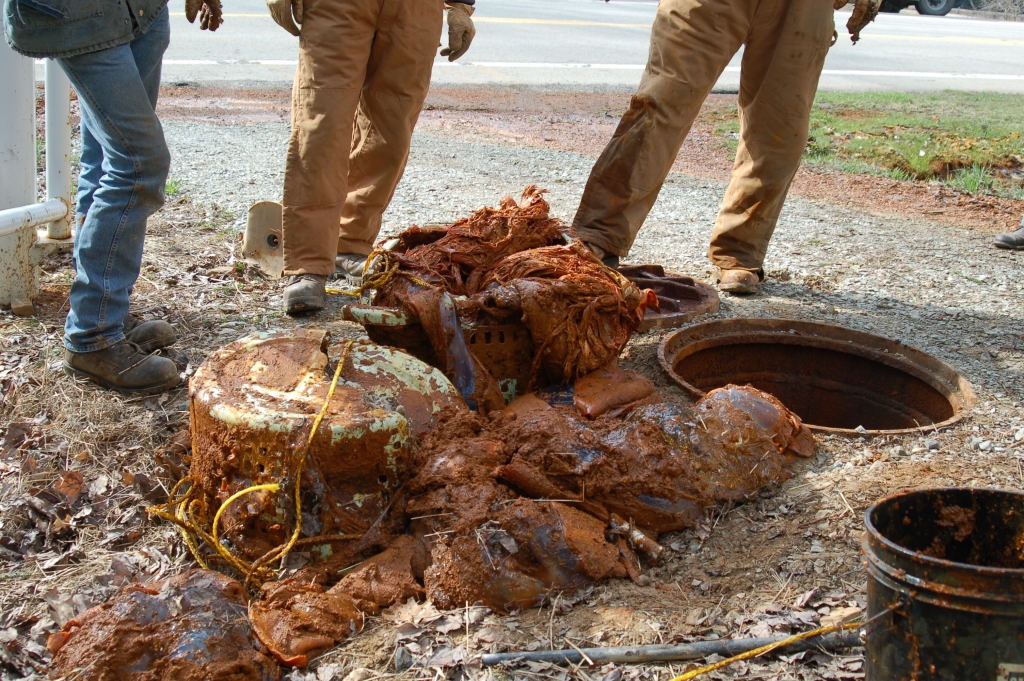As those of us doing the work of mine drainage remediation know, our projects need a whole lot of oversight and maintenance, repair and refurbishment. We do not necessarily expect them to fail. The Kalp Project (Anna and Steve Gdosky Indian Creek Restoration Project) was built in 2006 and came on-line in 2007 after five long years of struggling to purchase the site, obtain permits from the US Army Corps of Engineers, arrange and secure numerous easements to use and cross private land, and make sure we had enough funds to build it, roughly $3.4 million. After all of this work and seemingly successful construction, this project proved the challenging reality of AMD remediation – difficult maintenance needs, several costly upgrades and repairs, and much more time and determination.
The purpose of this project was to treat and remove significant amounts of iron and aluminum from the worst discharge in the Indian Creek Watershed. Perhaps more urgent was the fact that as a result of the project, the Kalp mine pool, flowing in the hillside above the village of Melcroft, was dewatered to a safe level. During the 1st phase of the project, directional drilling was used to bore into the mine to carry out an emergency drawdown of millions of gallons of contaminated water. This removed the threat of a blowout, which would have destroyed homes, caused possible loss of life and could have wiped out Indian Creek all the way to the Youghiogheny.
Over the ensuing years, however, this threat would return numerous times as unforeseen issues with the treatment system arose.
The first issue arose in 2008.
We observed during routine maintenance that the Kalp Mine Pool elevation was increasing. We concluded that the pipes leading into the treatment system must be clogged. We organized a work day with the DEP Bureau of Abandoned Mine Reclamation, Natural Resources Conservation Service (NRCS), and Stoy Excavating to stop the flow into a distribution manhole and clean out the pipes. As soon as the water level fell, a mass of striated red material could be seen in the bottom of the manhole. What was it?
The NRCS representative told us that someone tried to sabotage the system. No one knew what the substance was. They said to call Hazmat.
Shortly, Hazmat, the state police, and the Fayette County Coroner were at the scene.
What was it? It was not radioactive or acidic, but even more importantly, it was not a body. Someone had deliberately dumped two bushel baskets full of a gelatinous material into the manhole. We concluded that it was indeed a sabotage, but many questions still remain. After this material was removed, the system returned to normalcy.

Then, in the spring of 2012, we noticed less water moving through the system (again).
The pipes leading from the mine into the treatment system, crossing under Route 711, were clogged. Not only was the mine pool dangerously rising, but it was also once more discharging out of the old Kalp mine opening, circumventing the treatment system. It had also started to discharge raw mine water into a neighbor’s driveway ditch, a discharge that had stopped since we dewatered the mine pool.
This clog was even more difficult to remove. Due to a design flaw, there was no cleanout pipe in a critical area. So, MWA applied for a Western Pennsylvania Coalition of Abandoned Mine Reclamation (WPCAMR) Quick Response grant to repair the system. We were given the funds to add a cleanout and pay a contractor to clean out the pipes.
For the next several months, the mine pool dropped steadily day to day and the discharges were no longer circumventing the treatment system. Then, suddenly, the elevation in the mine pool started to increase once more.
By January of 2013, the discharge was pouring out of the old mining opening again. We were back where we started.
Somehow, this time the fix was even more complicated!
The horizontal channels leading to the mine pool were clogged, and after the DEP was unable to clean them out more than a few hundred feet, we realized that they were completely blocked because the boreholes had collapsed. We needed to re-drill the boreholes into the mine pool, and this time, they needed to be cased the entire distance, not just the first 50 feet.
By convincing the DEP that this was an emergency, it only took a few weeks before construction was begun. During the emergency work, caustic soda was used to treat the additional discharge from the mine pool.

After this emergency work was finished, MWA still had to fully rehabilitate the Kalp system. With funding from a Growing Greener grant, rehabilitation was conducted in three phases that took approximately six weeks to complete. And, of course, this was not without several unforeseen obstacles that had to be overcome during the completion of this project, including a change in scope that required us to seek additional funding.

Finally, the mine drainage was once again being properly treated by the Kalp Treatment system before discharging into Indian Creek.
The Kalp treatment system rehabilitations were truly the valiant efforts of many, and continued maintenance and regular cleanings are necessary to make sure it continues to work properly. Once mining takes place, it is difficult to determine or control what is going on underground. The result is often mine pool blowouts, mine drainage contaminating our streams, and death to eco-systems. This is one of the reasons coal should remain in the ground.

